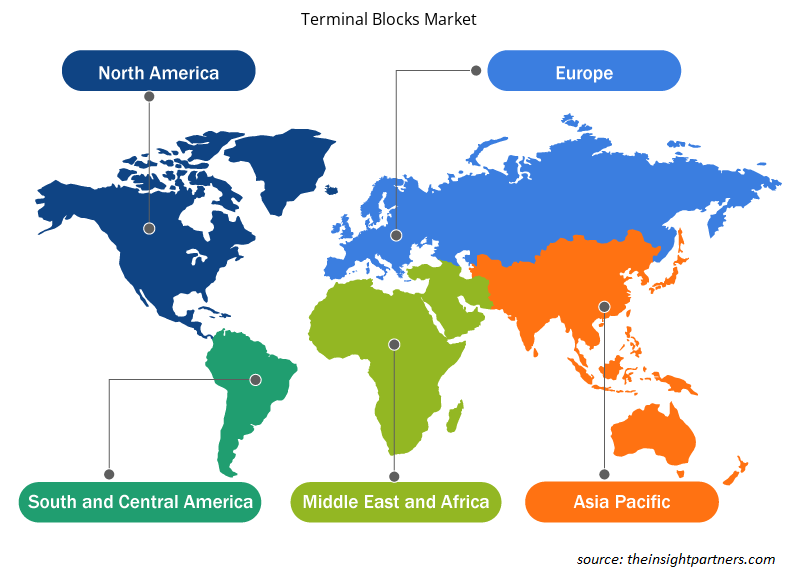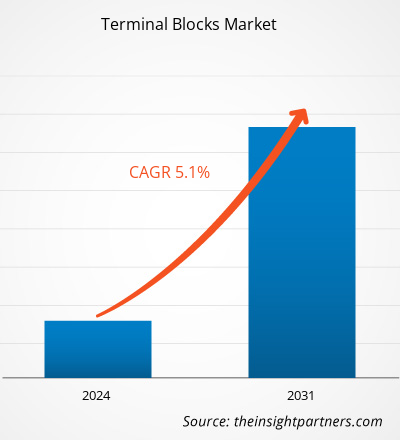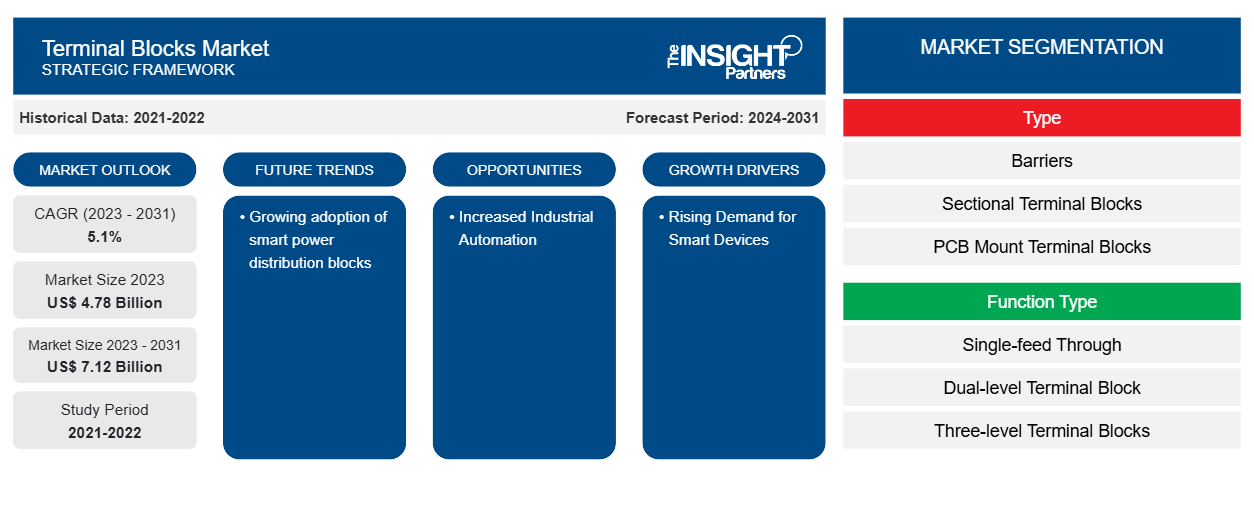Der Markt für Klemmenblöcke soll von 4,78 Milliarden US-Dollar im Jahr 2023 auf 7,12 Milliarden US-Dollar im Jahr 2031 anwachsen. Der Markt wird zwischen 2023 und 2031 voraussichtlich eine durchschnittliche jährliche Wachstumsrate von 5,1 % verzeichnen. Die zunehmende Einführung intelligenter Stromverteilerblöcke dürfte ein wichtiger Trend auf dem Markt bleiben.
Klemmenblöcke Marktanalyse
Der Bedarf an energieeffizienter Elektronik, die Umsetzung fortschrittlicher Fertigungsstrategien, die steigende Nachfrage nach intelligenten Geräten und die zunehmende Verbreitung moderner und verbesserter Technologien in der Unterhaltungselektronik sind die wichtigsten Faktoren, die die Nachfrage nach Leiterplatten antreiben und letztendlich den Bedarf an Klemmenblöcken steigern.
Marktübersicht für Klemmenblöcke
Ein Klemmenblock ist ein modularer Steckverbinder, der eine zuverlässige Verbindung durch Verbinden von zwei oder mehr Drähten und Verwalten komplexer elektrischer Schaltkreise ermöglicht . Er wird auch verwendet, um Drähte an Erdungs- oder Erdungsanschlüsse anzuschließen. Die Außenkörper von Klemmenblöcken bestehen normalerweise aus Melamin oder Polyamid. Klemmenblöcke verwenden hauptsächlich eine Kupferlegierung, um einen extrem niedrigen Kontaktwiderstand zu erreichen. Die Drähte werden mithilfe von Klemmen, bei denen es sich um Schraubklemmen, Federklemmen, Muttern und Schrauben oder Bolzen handeln kann, fest mit Stromschienen verbunden. Es gibt verschiedene Arten von Kabelschuhen oder Aderendhülsen zum Anbringen von Drähten an Klemmenblöcken, darunter stiftförmige, röhrenförmige, hakenförmige, gabelförmige und ringförmige Kabelschuhe, je nach Anwendungsbereich sowie Strom- und Spannungswerten.
Passen Sie diesen Bericht Ihren Anforderungen an
Sie erhalten kostenlos individuelle Anpassungen an jedem Bericht, einschließlich Teilen dieses Berichts oder einer Analyse auf Länderebene, eines Excel-Datenpakets sowie tolle Angebote und Rabatte für Start-ups und Universitäten.
-
Holen Sie sich die wichtigsten Markttrends aus diesem Bericht.Dieses KOSTENLOSE Beispiel umfasst eine Datenanalyse von Markttrends bis hin zu Schätzungen und Prognosen.
Markttreiber und Chancen für Klemmenblöcke
Steigende Nachfrage nach intelligenten Geräten begünstigt den Markt
Die steigende Nachfrage nach intelligenten Geräten wird voraussichtlich die Klemmenblockindustrie voranbringen. Ein intelligentes Gerät ist ein elektronisches Gerät, das drahtlos oder per Kabel mit anderen Geräten kommunizieren kann. Klemmenblöcke werden verwendet, um elektrische Systeme zu verbinden, zu organisieren und zu sichern. Laut Mediapost, einem in den USA ansässigen Medienunternehmen, sind rund 22 Millionen Haushalte mit intelligenten Geräten ausgestattet; davon haben 69 % der Haushalte in den Vereinigten Staaten mindestens ein intelligentes Gerät, und Prognosen zufolge werden bis 2023 15 % der Haushalte weltweit ein Smart-Home-Gerät installiert haben. Infolgedessen treibt die steigende Nachfrage nach intelligenten Geräten den Klemmenblockmarkt an.
Erhöhte industrielle Automatisierung
Der Markt für Klemmenblöcke dürfte mit zunehmender Verbreitung der industriellen Automatisierung schneller wachsen. Bei der industriellen Automatisierung werden autonome Systeme wie Roboter und Computersoftware eingesetzt, um Maschinen und Prozesse in einer Vielzahl von Branchen zu steuern und so Präzision und Flexibilität zu verbessern. Ein erheblicher Teil der industriellen Automatisierung basiert auf komplexen Steuerungssystemen, die genaue und zuverlässige elektrische Verbindungen erfordern. Klemmenblöcke sind wichtige Komponenten dieser Systeme, da sie eine sichere und strukturierte Möglichkeit zum Anschließen und Verteilen von Strom und elektrischen Signalen bieten.
Segmentierungsanalyse des Marktberichts für Klemmenblöcke
Wichtige Segmente, die zur Ableitung der Marktanalyse für Klemmenblöcke beigetragen haben, sind Typ, Funktionstyp,Verbindungstechnologien, Branche und Gerätetyp.
- Nach Typ ist der Markt segmentiert nach Barrieren, Sektionsklemmenblöcken, Klemmenblöcken für die Leiterplattenmontage, Stromblöcken und anderen. Das Segment der Sektionsklemmenblöcke hatte im Jahr 2023 einen bedeutenden Marktanteil.
- Basierend auf dem Funktionstyp ist der Markt in Einzeldurchführungs-, Doppelstock-Klemmenblöcke und Dreistock-Klemmenblöcke segmentiert. Das Einzeldurchführungssegment hatte im Jahr 2023 einen größeren Marktanteil.
- Basierend auf Verbindungstechnologien ist der Markt in Federklemmklemmen, Schraubklemmen, Schneidklemmverbindungen, Push-In-Klemmenblöcke und Barrieren segmentiert. Das Segment der Federklemmklemmenblöcke hatte im Jahr 2023 einen größeren Marktanteil.
- Basierend auf der Branche ist der Markt in Geschäftsausstattung, HLK, Stromversorgung, Industriesteuerungen, Instrumente, Telekommunikationsausrüstung, Transport und andere segmentiert. Das HLK-Segment hatte 2023 den größten Marktanteil.
- Basierend auf dem Gerätetyp ist der Markt in Erdungsklemmen, Sicherungsklemmenblöcke und andere unterteilt. Das Segment Erdungsklemmen hatte im Jahr 2023 den größten Marktanteil.
Marktanteilsanalyse für Klemmenblöcke nach Geografie
Der geografische Umfang des Marktberichts für Klemmenblöcke ist hauptsächlich in fünf Regionen unterteilt: Nordamerika, Asien-Pazifik, Europa, Naher Osten und Afrika sowie Süd- und Mittelamerika.
Der asiatisch-pazifische Raum dominierte 2023 den Markt für Klemmenblöcke. Der Bedarf an Leiterplatten steigt aufgrund des wachsenden Bedarfs an energieeffizienter Elektronik, des Einsatzes hochentwickelter Produktionsprozesse, der steigenden Nachfrage nach intelligenten Geräten und der zunehmenden Akzeptanz aktueller und verbesserter Technologie in der Unterhaltungselektronik. Wachsende Investitionen in den Elektroniksektor treiben den Bedarf an Leiterplatten in die Höhe. So genehmigte die indische Regierung im Dezember 2021 einen Anreizplan in Höhe von 10 Milliarden US-Dollar zum Bau von Halbleiter- und Displayfabriken im Land als Teil ihrer Strategie, zu einer Hochburg der Elektronikfertigung zu werden. Im Januar 2022 kündigte Intel seinen Plan an, mehr als 20 Milliarden US-Dollar in den Bau von zwei neuen Werken und die Errichtung eines neuen Zentrums für fortschrittliche Chipherstellung im Mittleren Westen zu investieren.
Regionale Einblicke in den Klemmenblockmarkt
Die regionalen Trends und Faktoren, die den Klemmenblockmarkt während des Prognosezeitraums beeinflussen, wurden von den Analysten von Insight Partners ausführlich erläutert. In diesem Abschnitt werden auch die Marktsegmente und die Geografie des Klemmenblockmarkts in Nordamerika, Europa, im asiatisch-pazifischen Raum, im Nahen Osten und Afrika sowie in Süd- und Mittelamerika erörtert.

- Holen Sie sich die regionalspezifischen Daten für den Klemmenblockmarkt
Umfang des Marktberichts zu Klemmenblöcken
| Berichtsattribut | Details |
|---|---|
| Marktgröße im Jahr 2023 | 4,78 Milliarden US-Dollar |
| Marktgröße bis 2031 | 7,12 Milliarden US-Dollar |
| Globale CAGR (2023 - 2031) | 5,1 % |
| Historische Daten | 2021-2022 |
| Prognosezeitraum | 2024–2031 |
| Abgedeckte Segmente |
Nach Typ
|
| Abgedeckte Regionen und Länder |
Nordamerika
|
| Marktführer und wichtige Unternehmensprofile |
|
Marktteilnehmerdichte für Klemmenblöcke: Auswirkungen auf die Geschäftsdynamik verstehen
Der Markt für Klemmenblöcke wächst rasant, angetrieben durch die steigende Nachfrage der Endnutzer aufgrund von Faktoren wie sich entwickelnden Verbraucherpräferenzen, technologischen Fortschritten und einem größeren Bewusstsein für die Vorteile des Produkts. Mit steigender Nachfrage erweitern Unternehmen ihr Angebot, entwickeln Innovationen, um die Bedürfnisse der Verbraucher zu erfüllen, und nutzen neue Trends, was das Marktwachstum weiter ankurbelt.
Die Marktteilnehmerdichte bezieht sich auf die Verteilung der Firmen oder Unternehmen, die in einem bestimmten Markt oder einer bestimmten Branche tätig sind. Sie gibt an, wie viele Wettbewerber (Marktteilnehmer) in einem bestimmten Marktraum im Verhältnis zu seiner Größe oder seinem gesamten Marktwert präsent sind.
Die wichtigsten auf dem Markt für Klemmenblöcke tätigen Unternehmen sind:
- ABB Ltd.
- Eaton Corporation PLC
- Metz Connect USA Inc.
- Molex LLC
- Phoenix Contact
- Rockwell Automation, Inc.
Haftungsausschluss : Die oben aufgeführten Unternehmen sind nicht in einer bestimmten Reihenfolge aufgeführt.

- Überblick über die wichtigsten Akteure auf dem Klemmenblockmarkt
Neuigkeiten und aktuelle Entwicklungen zum Klemmenblockmarkt
Der Markt für Klemmenblöcke wird durch die Erhebung qualitativer und quantitativer Daten nach Primär- und Sekundärforschung bewertet, die wichtige Unternehmensveröffentlichungen, Verbandsdaten und Datenbanken umfasst. Nachfolgend sind einige der Entwicklungen auf dem Markt für Klemmenblöcke aufgeführt:
- TE Connectivity hat SNACompact-Klemmenblöcke auf den Markt gebracht. Die SNACompact-Klemmenblockreihe ermöglicht ein hohes Maß an Produktivität auf kleinerem Raum und ist gleichzeitig eine Option für mittelständische Unternehmen, die nach einer wirtschaftlichen Lösung in einem Markt mit hohem Druck suchen. (Quelle: TE Connectivity, Pressemitteilung, November 2021)
- ABB hat eine neue Reihe von PI-Spring-Klemmenblöcken für Photovoltaikanlagen auf den Markt gebracht, die den Anschluss schneller und einfacher machen. Der patentierte Anschlussmechanismus von ABB ist bis zu 50 Prozent schneller als Klemmenblöcke mit Schraubklemmen oder Sammelschienenanschlüssen. (Quelle: ABB, Pressemitteilung, Februar 2019)
Marktbericht zu Klemmenblöcken – Umfang und Ergebnisse
Der Bericht „Marktgröße und Prognose für Klemmenblöcke (2021–2031)“ bietet eine detaillierte Analyse des Marktes, die die folgenden Bereiche abdeckt:
- Marktgröße und Prognose für Klemmenblöcke auf globaler, regionaler und Länderebene für alle wichtigen Marktsegmente, die im Rahmen des Berichts abgedeckt sind
- Markttrends für Klemmenblöcke sowie Marktdynamik wie Treiber, Einschränkungen und wichtige Chancen
- Detaillierte PEST/Porters Five Forces- und SWOT-Analyse
- Marktanalyse für Klemmenblöcke, die wichtige Markttrends, globale und regionale Rahmenbedingungen, wichtige Akteure, Vorschriften und aktuelle Marktentwicklungen umfasst
- Branchenlandschaft und Wettbewerbsanalyse, die die Marktkonzentration, Heatmap-Analyse, prominente Akteure und aktuelle Entwicklungen für den Klemmenblockmarkt umfasst
- Detaillierte Firmenprofile
- Historische Analyse (2 Jahre), Basisjahr, Prognose (7 Jahre) mit CAGR
- PEST- und SWOT-Analyse
- Marktgröße Wert/Volumen – Global, Regional, Land
- Branchen- und Wettbewerbslandschaft
- Excel-Datensatz
Aktuelle Berichte
Erfahrungsberichte
Grund zum Kauf
- Fundierte Entscheidungsfindung
- Marktdynamik verstehen
- Wettbewerbsanalyse
- Kundeneinblicke
- Marktprognosen
- Risikominimierung
- Strategische Planung
- Investitionsbegründung
- Identifizierung neuer Märkte
- Verbesserung von Marketingstrategien
- Steigerung der Betriebseffizienz
- Anpassung an regulatorische Trends























 Kostenlose Probe anfordern für - Markt für Klemmenblöcke
Kostenlose Probe anfordern für - Markt für Klemmenblöcke